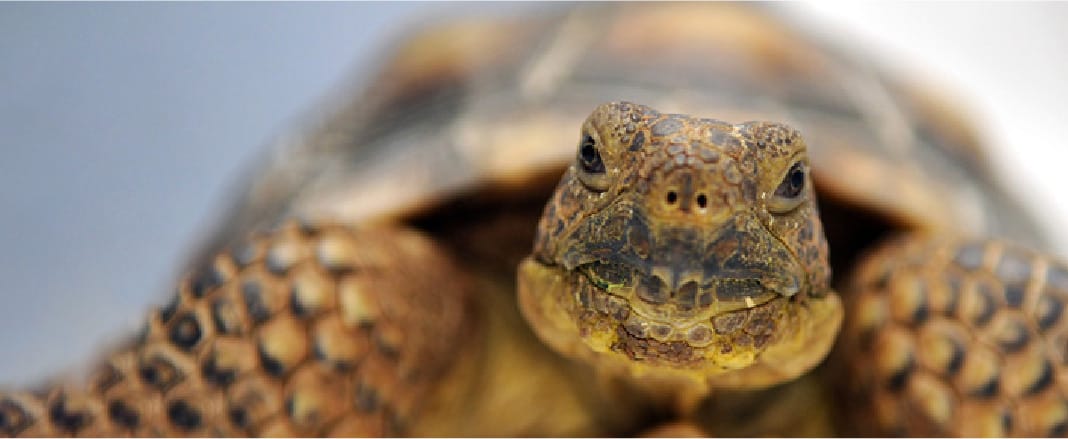
Captive Mojave
Desert Tortoises and the Overpopulation Problem
Mojave desert tortoises can be amazing pets; but they are a huge responsibility. When one tortoise leads to two, you can end up with dozens of little tortoises. It’s against the law and cruel to release them into the wild. Then what do you do?
Below are some great tips and resources to help you understand the dangers of backyard breeding, discover why captive breeding is not helping the wild tortoise population, what you can do to stop the breeding and a few interesting facts.

One is not the loneliest number when it comes to the Mojave desert tortoise – they are solitary creatures and prefer it that way.
The Problems with Backyard Breeding
No one wants to do more harm than good, especially when it comes to living creatures. Here are reasons why you should think twice about purposefully or unintentionally breeding tortoises in captivity.
- Overwhelming numbers of clutches (hatchlings) are being born. A single female tortoise in captivity can lay 1-15 eggs in a clutch and up to 3 clutches in a year – up to 45 babies from one female.
- People no longer want to or are able to take care of their pet tortoises – and dump them illegally in the wild.
- Backyard-bred tortoises carry a highly contagious and potentially lethal upper respiratory disease called URTD. Approximately 66% of tortoises screened through the Tortoise Group’s wellness clinics from 2016-2019 observed clinical symptoms of disease.
- Tortoises are great escape artists and easily tunnel their way out from their backyards and enclosures.
- People don’t know how to take care of pet tortoises and many tortoises end up dying or being abused.
- Inbreeding leads to negative genetic abnormalities of the species when tortoises are held in captivity.
- Hoarding of tortoises and lack of space in most backyards. Tortoises need very specific and uncrowded habitats to survive, which most backyards do not provide.
Captive tortoises can easily outlive you.
Why Captive Breeding Harms Wild Tortoises
You might think you’re doing the endangered wild tortoises a big favor. But you’re not. Here’s why.
- Mojave Desert tortoises are endangered in the wild, but release of backyard-bred tortoises endangers them even more.
- Pet tortoises can carry diseases that are potentially deadly to wild tortoises.
- Captive tortoises introduce weaker genetic strains into the wild and upset the ecosystem.
- Releasing captive tortoises can upset the wild tortoises’ social structure, stimulating fights for burrows, food and other resources.
- People no longer want to or are able to take care of their pet tortoises – and dump them illegally in the wild.
Keep captive tortoises captive. Keep wild tortoises wild.
Ways You Can Help
You can be part of the solution to help end captive tortoise overpopulation.
- Stop backyard breeding.
- House tortoises separately to reduce stress, avoid inbreeding and eliminate fighting and/or mating in captivity.
- Maintain one tortoise per household.
- Don’t release your pet tortoise into the wild.
- Help spread awareness of the Mojave desert tortoise backyard/captive breeding problem.
- Get your backyard tortoise sterilized (spayed/neutered).
- Escape-proof your backyard with solid material the tortoise can’t see through.
- Follow us on Facebook and watch us on YouTube.
- Visit our care meetings, tortoise clinics,community events,adoption services, yard consultations and educational programs.
- Download the ROaDS app.
- Report a lost or found Mojave desert tortoise.
- Adopt a desert tortoise.
- Schedule a Tortoise Group speaker for your event or classroom.
- Make a tax-deductible donation.
- Register and microchip your tortoise.
- Become a member of the Tortoise Group – we have a variety of annual and lifetime options.
Learn more about Mojave desert tortoises, volunteer, engage, donate, advocate and join the Tortoise Group.
Did You Know?
Interesting facts about our friends, the Mojave desert tortoises.
- It is illegal to release captive desert tortoises into the wild. See more laws.
- In the wild, only 1-5% of hatchling Mojave desert tortoises make it to sexual maturity. In captivity, with no predators, they can live for many decades.
- All desert tortoises in Nevada are considered wildlife and belong to the people of Nevada. Those who legally possess a desert tortoise are considered custodians, not owners, of the desert tortoise(s) in captivity.
- In 1989, Nevada designated the desert tortoise (Gopherus agassizii) the official state reptile, and wild desert tortoises are listed as threatened under the Endangered Species Act.
- Desert tortoises living in captivity have a greater chance of getting lost and run over on city streets than any other pet.
- Desert tortoises released into the wild may spread a disease to wild tortoises, get attacked by a predator, starve or freeze to death.
A Mojave desert tortoise can live 80-100 years.
